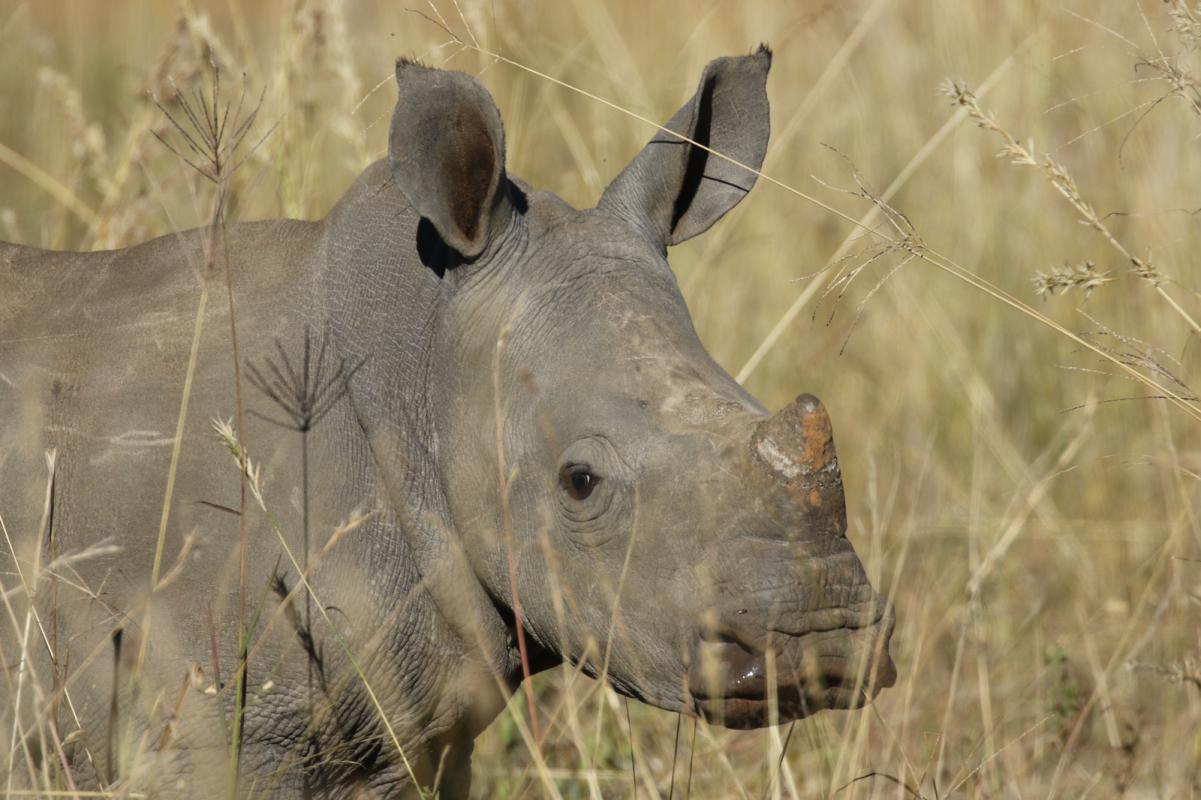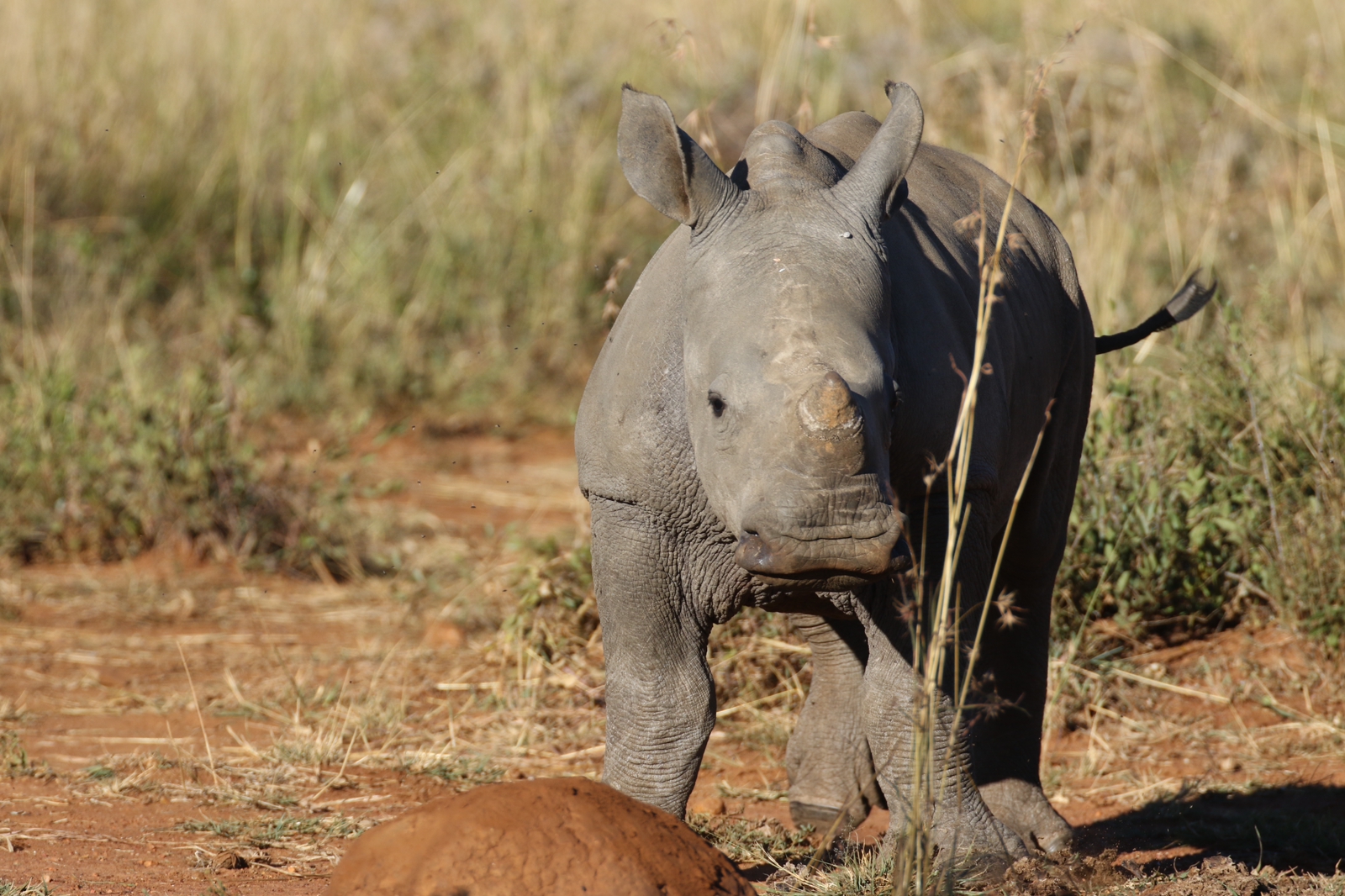
The challenges of breeding and conserving rhinos without trade
03 May 2023
South Africa’s privately-owned Platinum Rhino breeding and conservation project, the largest of its kind in the world, recently went on auction. The auction took place online from 26 April - 1 May 2023. The project has been in operation since 2009 and currently includes 2,000 southern white rhinos on an 8 500-hectare savannah landscape in South Africa. Unfortunately, barriers to international trade in rhino horn limited the ability of the operation to cover its costs.
The auction officially closed at 17:00 (CAT) on 1 May 2023, Save the Rhino Day. The opening bid was set at US$10 000 000 and not a single bid was made.
The family have now entered a period of consideration of all the offers of intent and John Hume will be holding personal discussions with these parties with the support of his family. Due of the magnitude of the Platinum Rhino Conservation Project this next phase could take a number of days and an announcement is expected to bel follow at the close of business on Friday 5 May 2023.
Dr Jane Wiltshire, a Research Fellow of the African Wildlife Economy Institute at Stellenbosch University, shared her perspective with local and international media on 2 May 2023. Here article follows as published in the Daily Maverick:
The Global ban on trade on rhino horn does not, and will not work
There were 29 rhino range states when the ban on trade in rhino horn was imposed in 1977. Today, only five range states remain with evolutionarily viable rhino populations.
At the end of April 2023, the owner of the largest rhino herd in the world put his whole rhino breeding operation up for auction. Will John Hume find a philanthropic billionaire who will buy his 2,000 rhinos and shoulder the heavy burden of protecting them from poachers as well as providing them with habitat?
The conservation world is rightly concerned about the potential impact on rhino numbers if there is not a “happy ending” for Hume’s rhinos. But this is only a part of the tragedy that is playing itself out all the time in South Africa — the Private Rhino Owners’ Association’s Pelham Jones estimates that already 80 private rhino owners have ceased owning rhinos, decreasing the land available to rhinos in South Africa by 430,000 hectares.
The cost of protecting these rhinos is simply too much for most private custodians.
Demand for rhino horn for traditional medicine, status gifts, and jewellery continues to be high; the only way this demand can be satisfied is via the procurement of illegal, poached horns as there is currently a 46-year ban on the international sale of rhino horn, binding on South Africa.
Billions of dollars of donations have gone into diverse, innovative and intensive anti-poaching campaigns and well-crafted demand-reduction campaigns.
But still, the relentless slaughter of rhinos continues.
The demand for rhino horn seems not to respond to education campaigns, and the incentive for poaching to supply this demand is enormous.
Meanwhile, rhino custodians are prevented from utilising sales of their rhino horn stockpiles and regular poaching-prevention horn-trimming to raise funding for anti-poaching and conservation of rhinos by the ban on international trade in rhino horn.

Legalising the international sale of rhino horn would mean that proceeds from this permanent demand would sustain rhino custodians, contribute tax to the South African Revenue Service, drive the growth of rural economies and create employment opportunities.
State conservation would receive a greatly needed shot in the arm and could become viable and self-sustaining.
Ecological benefit
Importantly, trade would result in an overall ecological benefit. A growing rhino population means the area in which rhinos are kept will increase. This would drive an increase in protected areas and the biodiversity they contain.
In addition, legal trade in rhino horn has the potential to satisfy five to eight times as much demand as poaching from the same number of rhinos because:
- A rhino’s horn can be harvested sustainably without harming the animal in any way, making the horn a renewable resource; and
- An adult rhino can produce between 0.75 and 1.5kg of horn per year — between five and eight horn sets in a 45-year lifetime.
In 2016, the government considered the results of a commission of inquiry (COI) to deliberate on possible trade in rhino horn. The COI, comprised of 22 panel members and incorporating the input of a further 65 dedicated experts, lasted two years.
After considering the options presented, the Cabinet concluded: “By facilitating a legal and well-regulated trade, it will be possible to supply some of the demand … [for rhino horn] from legal sources and generate funds for the conservation of rhinos…” and further decided that “an effective trade model” be developed once “governance issues were addressed”.
Why has the government not implemented its decision based on this robust and rigorous process that it initiated and paid for? As we await implementation, the slaughter of our rhinos continues — 3,684 rhinos were reportedly poached between 2017 and 2022.
Unfortunately, the government is not the only decision-maker in this process. CITES (the Convention on International Trade in Endangered Species) determines the ability of member nations (parties) to trade in wildlife products. A change in the classification of the products from a particular species requires a vote of at least two-thirds of the 184 parties.
Only five parties currently have viable African rhino populations (range states), but their vote counts the same as the non-range states.
The parties (especially non-range states) are influenced by animal rights NGOs which argue that the “precautionary principle” (PP) must be applied to any decision to lift the ban. The PP states that “the Parties shall, by virtue of the precautionary approach and in case of uncertainty … [of] … the impact of trade on the conservation of a species, act in the best interest of the conservation of the species concerned”.
It is odd that CITES has taken this to mean that the ban should not be lifted. The ban has patently been deleterious to rhinos:
- There were 29 range states when the ban was imposed in 1977. Today, only five range states remain with evolutionarily viable rhino populations; and
- The population of rhinos in the Kruger National Park, formerly home to the largest population of rhinos in the world, dropped from 10,621 in 2011 to 2,607 in 2020.
Despite this incontrovertible evidence of the harm that has come to rhinos during the ban, there are still those who argue that a bit more time, more vigorous implementation of anti-poaching and/or more stringent police and judicial processes will somehow remedy the dire and deteriorating situation.
After 46 years, billions of dollars spent, hundreds of conservationists’ lives lost and thousands of rhinos poached, it is clear that the ban on trade in rhino horn does not and will not work.
As long as the ban is in place, rhino custodians will be lumbered with the unsustainable, unfunded burden of protecting them — our rhinos will cost too much to keep.
Why not lift this deplorable ban on trade and make our precious rhinos once again worth more alive than dead?
-

Dr Jane Wiltshire
Expert Associate
We support the free flow of information. Please share:
More content
-

What Foot and Mouth Disease-free means for South Africa’s game meat trade
Ms Lydia Daring Bhebe…Explore the latest developments in South African provinces achieving and maintaining Foot and Mouth Disease (FMD) free status…
Articles -

The world wildlife trade regulator is 50 – here’s what has worked and what needs to change
Daniel Challender…Most countries implement Cites, the Convention on International Trade in Endangered Species of Wild Fauna and Flora as…Articles -

Enabling Sustainable Wildlife Trade
Prof Francis VorhiesEnabling sustainable wildlife trade is a key policy measure for growing Africa's wildlife economy. In this respect, CITES…
Articles -

Has CITES become too complicated to be effective?
Prof Francis VorhiesGovernments agreed to the text of CITES in the 1970s, which is quite straightforward. However, the agreement’s implementation…
Articles -

From poachers to providers: Can Africa's wild meat market save wildlife?
Dr Wiseman NdlovuHave you ever considered how wild meat could be more than just a cultural staple but also a…
Articles -

As a fellow of the African Wildlife Economy Institute (AWEI), I am excited to attend the upcoming 3rd…
Articles -

A theory of change to improve conservation outcomes through CITES
Dr Michael 't Sas-Rolfes…Here we articulate the implied theory of change (ToC) underpinning the design and operation of CITES (Convention on...
2025Research -

Wild Meat Value Chain Integration Systems: Opportunities for Value Chain Formalisation and Scaling in Africa
Dr Wiseman Ndlovu…Establishing a legal, safe and sustainable wild meat sector promises to potentially reduce demand for illegally sourced meat...
2025Research -

AWEI's 2024 Wildlife Economy Dialogue Series
Ms Emily TaylorRediscover 2024: A year of insight and inspiration
In 2024, AWEI proudly hosted three ground-breaking dialogue series in…
Articles
Get updates by email
Through impactful research, stakeholder engagement, and professional development, AWEI is supporting the wildlife economy across Africa. Please subscribe for occasional updates on our work and forthcoming events.
Sign up for a quarterly dose of AWEI insights
In a complex and changing world, AWEI generates strategic ideas, conducts independent analysis on wildlife economies, and collaborates with global scholar-practitioners to provide training and expertise for biodiversity conservation, climate resilience, and inclusive economic opportunities in Africa.
